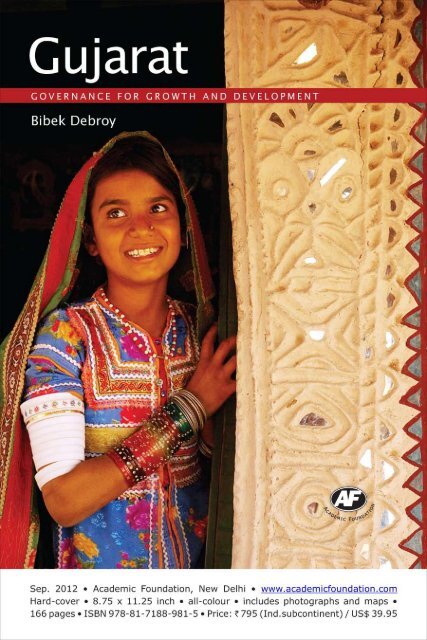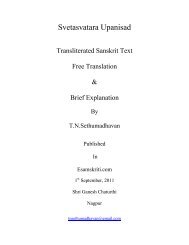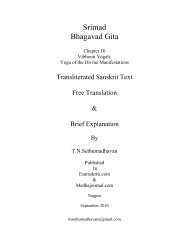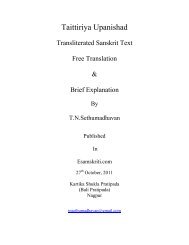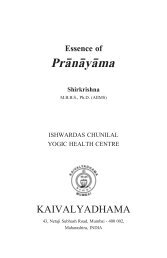Gujarat Governance for Growth and Development ... - Esamskriti.com
Gujarat Governance for Growth and Development ... - Esamskriti.com
Gujarat Governance for Growth and Development ... - Esamskriti.com
You also want an ePaper? Increase the reach of your titles
YUMPU automatically turns print PDFs into web optimized ePapers that Google loves.
<strong>Gujarat</strong><br />
<strong>Governance</strong> <strong>for</strong> <strong>Growth</strong> <strong>and</strong> <strong>Development</strong><br />
A preview of the book*<br />
<strong>Growth</strong><br />
There is a remarkable lack of objectivity in discussing <strong>Gujarat</strong> <strong>and</strong><br />
governance, growth <strong>and</strong> development there. The economics gets<br />
enmeshed in the politics <strong>and</strong> the politics gets entangled with the<br />
economics. While this is perhaps inevitable <strong>and</strong> unavoidable, this book<br />
is about the economics. What has happened in <strong>Gujarat</strong>? Is there a story<br />
there? Why has it happened? Is this is a story that can be replicated<br />
elsewhere in India? Is there a lesson <strong>for</strong> other States?<br />
The first broad-brush growth story is as follows. Compared to<br />
1994-95 to 2004-05, from 2004-05 to 2011-12, real GSDP (gross<br />
State domestic product) growth rates have increased, from an all-India<br />
average of 6.16% to an all-India average of 8.28%. Second, with an<br />
increase from 6.45% to 10.08%, the increase has been more <strong>for</strong> <strong>Gujarat</strong><br />
than <strong>for</strong> all-India. Third, since 2004-05, there are other States that<br />
have also grown fast <strong>and</strong> Bihar, Maharashtra, Sikkim, Tamil Nadu,<br />
Uttarakh<strong>and</strong>, Ch<strong>and</strong>igarh <strong>and</strong> Delhi are examples. That growth story<br />
in other States is sometimes used as an argument against the <strong>Gujarat</strong><br />
growth story <strong>and</strong> that’s a bit strange. After all, <strong>Gujarat</strong> accounts <strong>for</strong><br />
an estimated 7.5% of Indian GDP. If all-India averages have gone<br />
up that much, it is unreasonable to expect growth has been pulled<br />
up by <strong>Gujarat</strong> alone. However, in making inter-State <strong>com</strong>parisons,<br />
there is a legitimate question one should ask. Should small States<br />
be <strong>com</strong>pared with large States? Should special category States be<br />
<strong>com</strong>pared with non-special category States? Smaller States tend to<br />
* <strong>Gujarat</strong>: <strong>Governance</strong> <strong>for</strong> <strong>Growth</strong> <strong>and</strong> <strong>Development</strong>, Bibek Debroy, September 2012.<br />
Published by Academic Foundation, New Delhi; hardcover, pages 166, all colour–<br />
includes maps <strong>and</strong> photographs; ISBN 13: 9788171889815; Rs 795; US $39.95.<br />
www.academicfoundation.<strong>com</strong>
2<br />
< PREVIEW > <strong>Gujarat</strong>: <strong>Governance</strong> <strong>for</strong> <strong>Growth</strong> <strong>and</strong> <strong>Development</strong><br />
be more homogeneous, with relatively fewer backward geographical<br />
regions <strong>and</strong> districts. Ch<strong>and</strong>igarh, Delhi, Puducherry, Goa <strong>and</strong> Sikkim<br />
aren’t quite <strong>com</strong>parable with larger States. With that caveat, it is also<br />
true that there has been a growth pickup in Bihar, Maharashtra, Tamil<br />
Nadu <strong>and</strong> Uttarakh<strong>and</strong> as well. There has been a discernible pick-up<br />
in <strong>Gujarat</strong>’s growth per<strong>for</strong>mance since the 10th Plan (2002-07), the<br />
five-year Plans being natural periods <strong>for</strong> breaking up the time-line.<br />
It’s tempting to argue that there is nothing exceptional in this. <strong>Gujarat</strong><br />
grew fast during the 8th Plan (1992-97) too. While that’s true, one<br />
should accept that as development occurs, it be<strong>com</strong>es more difficult<br />
to sustain higher rates of growth. Among larger <strong>and</strong> relatively richer<br />
States like Maharashtra, Haryana, <strong>Gujarat</strong>, Kerala, Punjab, Tamil Nadu<br />
<strong>and</strong> Karnataka, it is more difficult to find sources of growth. <strong>Growth</strong><br />
tends to taper off. Relatively poorer States like Bihar, Orissa, Madhya<br />
Pradesh, Assam <strong>and</strong> Jharkh<strong>and</strong> find it easier to catch up. Had historical<br />
trends alone provided the momentum <strong>for</strong> growth, Karnataka should<br />
have also grown extremely fast. Fifth, too often, discussions focus on<br />
growth trends alone. Moving to a higher growth trajectory is important.<br />
But reducing the volatility of growth is no less important. <strong>Growth</strong> rates<br />
in <strong>Gujarat</strong> have be<strong>com</strong>e much less volatile. Given Indian conditions,<br />
volatility is fundamentally a function of what has been happening to the<br />
agricultural sector.<br />
Equity<br />
In line with all-India trends, overall poverty <strong>and</strong> urban poverty<br />
have declined in <strong>Gujarat</strong> between 2004-05 <strong>and</strong> 2009-10. But the real<br />
story is in rural <strong>Gujarat</strong>, where there has been a very sharp drop in<br />
poverty, significantly more than all-India trends. In rural <strong>Gujarat</strong>, the<br />
benefits of growth have trickled down. Subject to all those problems<br />
about data <strong>and</strong> measuring inequality, there is no evidence that<br />
inequality has increased.<br />
Fiscal consolidation<br />
Elimination of deprivation requires public intervention <strong>and</strong><br />
expenditure, over <strong>and</strong> above a State’s role in providing an enabling<br />
environment <strong>for</strong> private entrepreneurship to bloom <strong>and</strong> flourish <strong>and</strong><br />
ensuring rule of law. This requires public expenditure <strong>and</strong> fiscal
<strong>Gujarat</strong>: <strong>Governance</strong> <strong>for</strong> <strong>Growth</strong> <strong>and</strong> <strong>Development</strong> < PREVIEW ><br />
consolidation. Historically, the problem has been with the revenue<br />
deficit, especially after 2008, both because revenue receipts have been<br />
lower <strong>and</strong> because revenue expenditure has been higher. However,<br />
since 2011-12, the revenue deficit numbers have also begun to look<br />
respectable <strong>and</strong> the deficit numbers are marginally better than what<br />
the 13th Finance Commission envisaged. One of the building blocks<br />
of the <strong>Gujarat</strong> model, so to speak, is to free up space <strong>for</strong> private sector<br />
expenditure in capital <strong>for</strong>mation. One cannot expect capital expenditure,<br />
as a share, to increase overnight. The bulk (76%) of capital expenditure<br />
is developmental, with social services accounting <strong>for</strong> 55.2%. Of the<br />
total expenditure, 66.41% is also developmental. 63.2% of revenue<br />
expenditure is developmental. To the extent this reveals a prioritization<br />
according to sectors, the major ones are education, sports, art <strong>and</strong><br />
culture <strong>and</strong> water supply, sanitation, housing <strong>and</strong> urban development, in<br />
that order. The fiscal consolidation <strong>and</strong> fiscal space created has enabled<br />
<strong>Gujarat</strong> to plug the gaps in Central sector <strong>and</strong> Centrally sponsored<br />
schemes with State-level schemes. The story isn’t that much about<br />
increasing public expenditure. It is more about creating an environment<br />
<strong>for</strong> private expenditure. Apart from private expenditure, the story is<br />
about increasing the efficiency of public expenditure, more bang <strong>for</strong> the<br />
buck, so to speak.<br />
Physical infrastructure<br />
In the power sector, the background is partly the <strong>Gujarat</strong> Electricity<br />
Industry (Reorganization <strong>and</strong> Regulation) Act of 2003. This allowed the<br />
transfer of assets <strong>and</strong> liabilities of the <strong>for</strong>mer <strong>Gujarat</strong> Electricity Board<br />
(GEB). Generation assets were transferred to <strong>Gujarat</strong> State Electricity<br />
Corporation Limited (GSECL). Transmission assets were transferred<br />
to <strong>Gujarat</strong> Transmission Corporation Limited (GETCO). Four different<br />
distribution entities were <strong>for</strong>med – Uttar <strong>Gujarat</strong> Vij Company<br />
Limited (UGVCL), Dakshin <strong>Gujarat</strong> Vij Company Limited (DGVCL),<br />
Pashchim <strong>Gujarat</strong> Vij Company Limited (PGVCL) <strong>and</strong> Madhya <strong>Gujarat</strong><br />
Vij Company Limited (MGVCL). <strong>Gujarat</strong> Urja Vikas Nigam Limited<br />
(GUVNL) had residuary functions, including that of power trading.<br />
GUVNL was the holding <strong>com</strong>pany. The <strong>Gujarat</strong> Electricity Regulatory<br />
Commission had been set up in 1998 <strong>and</strong> was brought under the<br />
purview of the Electricity Act of 2003. Generation became exempt<br />
3
4<br />
< PREVIEW > <strong>Gujarat</strong>: <strong>Governance</strong> <strong>for</strong> <strong>Growth</strong> <strong>and</strong> <strong>Development</strong><br />
from licensing, including through non-conventional sources. Open<br />
access was allowed to transmission <strong>and</strong> distribution <strong>and</strong> distribution<br />
franchisees were introduced <strong>for</strong> distribution zones like Bhavnagar,<br />
Junagadh, Rajkot, Vishwamitri, Lalbaug, Bharuch, An<strong>and</strong> <strong>and</strong><br />
Mehsana. Metering became m<strong>and</strong>atory. In 2001, <strong>Gujarat</strong> was a power<br />
deficit State, by roughly around 2,000 MW. By the end of 2012, <strong>Gujarat</strong><br />
will have a power surplus, though expected increases in GSDP growth<br />
also increase the dem<strong>and</strong> <strong>for</strong> power. However, the <strong>Gujarat</strong> success<br />
story isn’t just about the macro generation situation. It is also about<br />
reduction in T&D losses, down from 35.90% in 2002-03 to 22.20% in<br />
2006-07. It is 20.13% in 2010-11. This is partly because T&D losses<br />
aren’t actually transmission <strong>and</strong> distribution losses. They are also about<br />
theft <strong>and</strong> unmetered supply. Other than metering, theft of electricity<br />
became a criminal offence <strong>and</strong> the law was en<strong>for</strong>ced, with distributors<br />
insulated from political pressures. There were special checking squads<br />
<strong>for</strong> checking installation, especially <strong>for</strong> HT connections, <strong>and</strong> ex-army<br />
personnel were roped in. In Sabarmati, Surat, Rajkot, Bhavnagar <strong>and</strong><br />
Baroda, there were special police stations <strong>for</strong> power theft. Provisions<br />
were made <strong>for</strong> sealed meters that were tamper-proof. Through an<br />
e-Urja project, electronic billing <strong>and</strong> payment was introduced. Faulty<br />
meters were replaced. Unauthorized connections were regularized<br />
through one-time settlements. The Jyotigram Yojana (JGY) ensures<br />
3-phase power supply to all villages. The key was a bifurcation of<br />
supply lines into dedicated agricultural feeders. For agricultural use,<br />
one would thus be ensured continuous power <strong>for</strong> 8 hours a day, at<br />
pre-determined times. For other rural loads (domestic, <strong>com</strong>mercial<br />
<strong>and</strong> industrial), there would be 24/7 power. 24/7 3-phase supply was<br />
provided to JGY feeders. These then provided 8 hours of 3-phase<br />
continuous supply to agricultural feeders <strong>and</strong> 1-phase 24/7 power to<br />
other rural uses. The argument about people wanting subsidized power<br />
<strong>and</strong> refusing to pay higher tariffs is misplaced. People are prepared<br />
to pay, provided that the quality of power supply improves. It was no<br />
different <strong>for</strong> JGY. Once power at pre-determined hours was available,<br />
there was less of an incentive to divert subsidized power <strong>for</strong> agriculture<br />
to domestic household use. JGY helped reduce T&D losses. It also<br />
helped reduce trans<strong>for</strong>mer failures. More importantly, it led to all<br />
villages being electrified, without load-shedding, <strong>and</strong> this had positive<br />
socio-economic multiplier benefits.
<strong>Gujarat</strong>: <strong>Governance</strong> <strong>for</strong> <strong>Growth</strong> <strong>and</strong> <strong>Development</strong> < PREVIEW ><br />
If power is important to better people’s lives, water is no less so.<br />
The overall picture is that <strong>Gujarat</strong> is a water scarce State. there are<br />
several str<strong>and</strong>s in the water sector re<strong>for</strong>ms – inter-basin transfer of<br />
water from surplus areas to deficit areas like north <strong>Gujarat</strong>, Saurashtra<br />
<strong>and</strong> Kachchh; the linking of canals; water conservation; participatory<br />
irrigation management; micro-irrigation; check dams <strong>and</strong> smaller dams<br />
(such as through the Sardar Patel Water Conservation Programme);<br />
deepening of ponds; cleaning <strong>and</strong> restoration of step wells; <strong>com</strong>munity<br />
management of water supply in villages through WASMO (Water <strong>and</strong><br />
Sanitation Management Organization); <strong>and</strong> the Sujalam Suphalam<br />
Yojana (SSY). Water has both a drinking water <strong>and</strong> an irrigation water<br />
<strong>com</strong>ponent. Something like SSY covers both. While the State has<br />
certainly gained because of Sardar Sarovar, that wouldn’t have been<br />
possible without the State-wide water supply grid.<br />
In terms of affecting people’s lives <strong>for</strong> the better, roads are just<br />
as important as electricity <strong>and</strong> water. Compared to many other States,<br />
<strong>Gujarat</strong> has always had relatively better road infrastructure. 98.27%<br />
of State Highways <strong>and</strong> 96.93% of major district roads possess asphalt<br />
surfaces. 85.63% of other district roads <strong>and</strong> village roads also possess<br />
asphalt surfaces. 98.84% of villages are connected by “pucca” roads.<br />
<strong>Gujarat</strong> has also benefited from NHDP. Given the base, the focus has<br />
thus been more on upgradation <strong>and</strong> maintenance, improving access<br />
in relatively disadvantaged regions, while simultaneously tapping<br />
the proposed dedicated freight corridor (DFC) between Delhi <strong>and</strong><br />
Mumbai <strong>and</strong> the Delhi-Mumbai Industrial Corridor (DMIC). In so<br />
far as relatively disadvantaged regions are concerned, the emphasis<br />
has been on all-weather connectivity, particularly in coastal, tribal<br />
<strong>and</strong> border areas. There have been several PPP projects, sometimes<br />
externally-aided, with provisions <strong>for</strong> tolls. The <strong>Gujarat</strong> Highways Bill<br />
of 2007 facilitated PPP projects. There is also a Pragati Path Yojana,<br />
<strong>for</strong> improvement of State Highways, part of which has been <strong>com</strong>pleted.<br />
In addition, <strong>for</strong> major projects, third party inspection <strong>and</strong> monitoring<br />
has been introduced. Maintenance guarantees of 3 to 5 years are<br />
incorporated in contracts. IT tools have been used <strong>for</strong> physical<br />
monitoring, registration of contractors, court cases <strong>and</strong> departmental<br />
enquiries. In high rainfall districts like Navasari <strong>and</strong> Surat, village<br />
roads have been constructed with cement/concrete.<br />
5
6<br />
< PREVIEW > <strong>Gujarat</strong>: <strong>Governance</strong> <strong>for</strong> <strong>Growth</strong> <strong>and</strong> <strong>Development</strong><br />
A point was made earlier about <strong>Gujarat</strong>’s ability to plug gaps in<br />
Central schemes with State-level ones. In the context or urban planning,<br />
the relevant ones are the Garib Samruddhi Yojana (GSY) <strong>and</strong> the<br />
SJMMSVY (Swarnim Jayanti Mukhya Mantri Shaheri Vikas Yojana).<br />
While on the subject of urban planning, or planning in general, it is odd<br />
that one of <strong>Gujarat</strong>’s remarkable successes doesn’t get written about<br />
that much. This is the use of GIS maps in decision making. This is<br />
through the Bhaskaracharya Institute <strong>for</strong> Space Applications <strong>and</strong> Geo-<br />
In<strong>for</strong>matics (BISAG), a State-level nodal agency set up in 1997 <strong>and</strong><br />
renamed BISAG in 2003. BISAG also conducts training programmes<br />
<strong>and</strong> workshops <strong>and</strong> is involved in delivering over the <strong>Gujarat</strong> SATCOM<br />
network. But more importantly, it uses remote sensing <strong>and</strong> GIS to<br />
facilitate planning. These GIS maps with several layers have already<br />
been introduced in all the municipalities. Among other things, this is<br />
certainly one initiative that other States should replicate.<br />
Education<br />
In social infrastructure, like education, some of <strong>Gujarat</strong>’s figures<br />
may not look that bad if <strong>com</strong>parisons are made with all-India averages.<br />
However, <strong>for</strong> an economically developed State like <strong>Gujarat</strong>, is an all-<br />
India average the right benchmark to use? Or, in the area of education,<br />
should <strong>Gujarat</strong> be benchmarked against better States? Having said this,<br />
there are two additional points to be borne in mind. First, have there<br />
been temporal improvements over time <strong>and</strong> have remedial measures<br />
been taken? There has been a sharp decline in the number of out-ofschool<br />
children between 2006 <strong>and</strong> 2011. Those improvements also<br />
<strong>com</strong>e across in National University of Educational Planning <strong>and</strong><br />
Administration’s DISE (District In<strong>for</strong>mation System <strong>for</strong> Education)<br />
dataset. For example, the average number of classrooms per school<br />
has increased. The student/classroom ratios have also improved. The<br />
percentage of single-teacher schools has declined. Pupil/teacher ratios<br />
have improved. Physical infrastructure is also far better. Consequently,<br />
if one has an impression that <strong>Gujarat</strong> doesn’t do that well on school<br />
education, one should check the time-line. Many interventions are of<br />
recent vintage <strong>and</strong> dated data don’t show the improvements. One such<br />
intervention is “Praveshotsava” <strong>and</strong> “Rathyatra”, targeted at festivals<br />
of admission, particularly <strong>for</strong> girls. In 2002-03, a Vidya Laxmi Bond<br />
scheme was started, <strong>for</strong> girls, initially in rural areas, but also extended
<strong>Gujarat</strong>: <strong>Governance</strong> <strong>for</strong> <strong>Growth</strong> <strong>and</strong> <strong>Development</strong> < PREVIEW ><br />
to urban BPL families. A sum of money is deposited at the time of<br />
admission (in Class I) <strong>and</strong> this is repaid with interest when the girl<br />
passes out of Class VII. Apart from this, there have been improvements<br />
in physical infrastructure, some of this under the Van B<strong>and</strong>hu scheme<br />
<strong>for</strong> tribal talukas <strong>and</strong> the Sagar Khedu scheme <strong>for</strong> coastal talukas,<br />
planning facilitated by the BISAG mapping mentioned earlier.<br />
Biometric monitoring of attendance has also been introduced. One<br />
should mention the Gunotsav programme, designed to improve quality<br />
in 34,000 primary government schools.<br />
Health<br />
The case <strong>for</strong> market failure is generally greater <strong>for</strong> health than it<br />
is <strong>for</strong> education. If there is a perception that <strong>Gujarat</strong> doesn’t do that<br />
well in social sectors, that’s truer of health than of education. As with<br />
education, there is a time-line issue there too. Since the public healthcare<br />
infrastructure is weak, the Chiranjivi Yojana taps the private<br />
sector, to employ private sector specialists in safe delivery. While the<br />
poor household doesn’t have to pay, the government pays the private<br />
sector specialist. The Chiranjivi Yojana was first introduced on pilot<br />
basis in 2005 <strong>and</strong> has picked up since then. The Bal Sakha Yojana<br />
has a similar PPP idea. It was launched in 2009 <strong>and</strong> covers all BPL<br />
households <strong>and</strong> tribal households, even if they happen to be APL. Neonatal<br />
care is provided by private enrolled pediatricians, who are then<br />
reimbursed by the State. Health-care has several dimensions. There<br />
is the preventive part, interpreted as clean drinking water, sanitation,<br />
sewage treatment <strong>and</strong> nutrition, be it through MDMS, ICDS, vitamin<br />
supplements or otherwise. There is also the preventive part, interpreted<br />
as immunization. The State government’s focus has clearly been on<br />
reducing neo-natal deaths <strong>and</strong> bringing down the IMR <strong>and</strong> MMR. That’s<br />
where the Janani Suraksha Yojana (JSY) <strong>com</strong>es in, designed to shift<br />
poor women to institutional delivery. The percentage of institutional<br />
deliveries has sharply gone up from 55.87% in 2003-04 to 93.5% in<br />
2011-12. Immunization coverage has also increased. There has been an<br />
IMNCI (Integrated Management of New Born <strong>and</strong> Childhood Illness),<br />
launched in 2005, <strong>com</strong>bined with Mamta (Malnutrition Assessment <strong>and</strong><br />
Monitoring to Act) initiatives, which effectively register a mother <strong>and</strong><br />
child <strong>and</strong> track post-natal nutrition, health <strong>and</strong> immunization status.<br />
Perhaps the most interesting of all these experiments is the emergency<br />
7
8<br />
< PREVIEW > <strong>Gujarat</strong>: <strong>Governance</strong> <strong>for</strong> <strong>Growth</strong> <strong>and</strong> <strong>Development</strong><br />
108 number, which is not just <strong>for</strong> medical emergencies, but <strong>for</strong> police<br />
<strong>and</strong> fire emergencies too. This was launched in 2007 <strong>and</strong> is operated by<br />
GVK Emergency Management <strong>and</strong> Research Institute (EMRI).<br />
<strong>Governance</strong><br />
<strong>Gujarat</strong>’s economy has often been written about. Rarely have<br />
people written about governance, at least directly. But without talking<br />
about governance, it is difficult to appreciate what has happened in the<br />
State. E-governance is part of the answer, since it reduces the human<br />
interface. There have been several e-governance initiatives in <strong>Gujarat</strong><br />
<strong>and</strong> e-governance has be<strong>com</strong>e functional in all municipalities <strong>and</strong><br />
municipal corporations. Among the ones that have received awards are<br />
e-MAMTA, ICT solutions <strong>for</strong> planning <strong>and</strong> monitoring MGNREGS<br />
works, OASIS (on-line application <strong>and</strong> scrutiny of inter-State<br />
transactions), e-governance of mineral administration, e-governance<br />
initiatives <strong>and</strong> ICT initiatives in the Chief Minister’s Office, on-line<br />
voting, e-dhara in the Revenue Department <strong>for</strong> <strong>com</strong>puterization of l<strong>and</strong><br />
records, SWAGAT (State-Wide Attention on Grievances by Application<br />
of Technology) in the Chief Minister’s Office, the Integrated Watershed<br />
Management Programme (IWMP), e-procurement by the Industry <strong>and</strong><br />
Mines Department, Value Added Tax In<strong>for</strong>mation System (VATIS) in<br />
the Office of Commercial Taxes, the Hospital Management In<strong>for</strong>mation<br />
System (HMIS) of the Health <strong>and</strong> Family Welfare Department, the<br />
Integrated Financial Management System (IFMS) in the Finance<br />
Department <strong>and</strong> ICT usage within the judiciary. A GSWAN (<strong>Gujarat</strong><br />
State Wide Area Network) connects government offices, down to the<br />
level of talukas. The e-Gram Vishvagram project connects 13,716 gram<br />
panchayats <strong>and</strong> 6000 Common Service Centres.<br />
If awareness is the first plank of improved governance, elimination<br />
of discretion <strong>and</strong> monopoly is the second. In both education <strong>and</strong> health,<br />
instances have been given earlier of moving away from traditional<br />
government monopolies in delivery. All district offices have Jan Seva<br />
Kendras <strong>and</strong> there are civic centres too, in municipalities <strong>and</strong> municipal<br />
corporations. At these, assorted certificates (caste, domicile, residence,<br />
birth, death), affidavits, driving licences <strong>and</strong> ration cards are issued the<br />
same day. Under the e-gram project, some of these have also been taken<br />
down to taluka <strong>and</strong> gram panchayats, facilitated by <strong>com</strong>puterization of
<strong>Gujarat</strong>: <strong>Governance</strong> <strong>for</strong> <strong>Growth</strong> <strong>and</strong> <strong>Development</strong> < PREVIEW ><br />
l<strong>and</strong> records. There has been third party audit of such Jan Seva Kendras<br />
too. The third element of improved governance is decentralization<br />
<strong>and</strong> participatory planning <strong>and</strong> there is a feedback loop from citizens<br />
to government, to suggest ideas to the government. Fourth, the<br />
decentralization has now gone down to the level of the taluka. Fifth,<br />
that improved governance is also a function of altered mindsets in the<br />
bureaucracy, which received a clear focus after the rehabilitation work<br />
connected with the 2001 earthquake was over. The Chintan Shibirs,<br />
annual retreats of Ministers <strong>and</strong> senior bureaucrats, have been going<br />
on since 2003 <strong>and</strong> are illustrative. Other than the obvious synergies of<br />
such retreats, these ensured that government does not work in silos <strong>and</strong><br />
departments <strong>and</strong> enabled cross-fertilization of ideas. For example, the<br />
idea of each officer at district <strong>and</strong> taluka levels taking up an innovative<br />
project, without financial constraints, emerged through such a Chintan<br />
Shibir. Kanya Kelvani, Praveshotsava, Gunotsava, Krishi Melas <strong>and</strong><br />
participation in gram sabha meetings are other instances of taking<br />
bureaucracy down to the grassroots. Better <strong>for</strong>mulation of schemes,<br />
<strong>and</strong> better implementation, have resulted. Within government, there is a<br />
database of employees <strong>and</strong> suggestions <strong>for</strong> better governance have been<br />
invited from employees. Transfers, postings <strong>and</strong> implementation have<br />
be<strong>com</strong>e more insulated from political interference.<br />
Sectoral issues<br />
In any discussion of any country or State’s economy, it is<br />
customary to discuss sectoral <strong>com</strong>positions of GDP or GSDP early<br />
on – primary/agriculture, secondary/industry, tertiary/services etc.<br />
In popular perception, at least in some quarters, <strong>Gujarat</strong>’s economic<br />
growth is about industry. <strong>Gujarat</strong> is about an investment destination<br />
<strong>for</strong> industries, about Vibrant <strong>Gujarat</strong>. It is about sectors like bio-tech<br />
<strong>and</strong> pharmaceuticals, chemicals <strong>and</strong> petrochemicals, engineering,<br />
automobiles <strong>and</strong> ancillaries, food <strong>and</strong> agri-business, gas, oil <strong>and</strong><br />
power, gems <strong>and</strong> jewellery <strong>and</strong> IT. Industry isn’t just about large-scale<br />
industry. That’s a misconception. The 2009-10 survey of the Annual<br />
Survey of Industries (ASI) covered the entire factory sector. This<br />
shows an increase in the number of factories to 15,576 <strong>and</strong> 9.8% of<br />
India’s factories are in <strong>Gujarat</strong>. At 13.22%, the share is higher in net<br />
value added. In decreasing order of importance, these factories are in<br />
segments like chemical <strong>and</strong> chemical products, basic metals, machinery<br />
9
10<br />
< PREVIEW > <strong>Gujarat</strong>: <strong>Governance</strong> <strong>for</strong> <strong>Growth</strong> <strong>and</strong> <strong>Development</strong><br />
<strong>and</strong> equipment, non-metallic mineral products, textiles, food products<br />
<strong>and</strong> pharmaceuticals. Together, they provided employment of 1.2<br />
million. Provisional figures show an increase in the number of factories<br />
to 25,206 in 2010, with an employment of 1.3 million. 0.13 million<br />
MSME enterprises in <strong>Gujarat</strong> were in 369 clusters, a pattern also<br />
exhibited in Tamil Nadu <strong>and</strong> Uttar Pradesh, cluster being defined as a<br />
concentration in manufacture of the same product group. This suggests<br />
that the positive externalities of cluster <strong>for</strong>mation have tended to work<br />
<strong>and</strong> in all probability, many of these MSME enterprises per<strong>for</strong>m an<br />
ancillary function. Also interestingly, at least <strong>for</strong> SSI, there has been<br />
a sharp increase in the number of registered units. There<strong>for</strong>e, it is<br />
plausible to presume that transaction costs associated with registration<br />
have declined, there are greater benefits associated with registration<br />
<strong>and</strong> the tax en<strong>for</strong>cement machinery has improved. At the lower end of<br />
the industrialization spectrum are cottage <strong>and</strong> rural industries. There<br />
are cluster development schemes <strong>for</strong> khadi, h<strong>and</strong>looms, h<strong>and</strong>icrafts<br />
<strong>and</strong> skill upgradation <strong>and</strong> market development schemes. Other than<br />
schemes like Sagar Khedu Yojana, Vanb<strong>and</strong>u Kalyan Yojana, Garib<br />
Samruddhi Yojana <strong>and</strong> even Garib Kalyan Melas, something like<br />
Mission Mangalam is also an attempt to integrate animal husb<strong>and</strong>ry,<br />
agro processing, food processing, aquaculture, processing of <strong>for</strong>est<br />
products, h<strong>and</strong>looms, h<strong>and</strong>icrafts, garments, bamboo <strong>and</strong> timber<br />
products into markets, through Sakhi M<strong>and</strong>als, self-help groups (SHGs)<br />
<strong>and</strong> other <strong>com</strong>munities of the poor. <strong>Gujarat</strong> Livelihood Promotion<br />
Company Limited (GLPC) was set up in 2010 to implement Mission<br />
Mangalam. Part of this inclusion is a financial inclusion agenda.<br />
<strong>Gujarat</strong> is known as a State with a strong manufacturing base <strong>and</strong><br />
in constant prices, the primary sector’s share in GSDP has declined<br />
from 19.5% in 2004-05 to 14.6% in 2010-11, a decline that was<br />
mentioned be<strong>for</strong>e. Agriculture’s share (this includes animal husb<strong>and</strong>ry)<br />
has declined from 13.2% in 2004-05 to 10.9% in 2010-11. While the<br />
share has declined, the growth rate of <strong>Gujarat</strong>’s agriculture, especially<br />
since 2000, has been remarkable <strong>and</strong> has been <strong>com</strong>mented upon.<br />
<strong>Gujarat</strong>’s agriculture has grown at more than 10%. In addition to water,<br />
electricity <strong>and</strong> roads, there have been other factors too. The Krushi<br />
Mahotsav programme was started in 2005 <strong>and</strong> is a month-long mass<br />
contact programme with farmers, including mobile “Krushi Raths”. Soil<br />
health cards are issued <strong>for</strong> every plot of l<strong>and</strong>. The <strong>Gujarat</strong> Cooperatives
<strong>Gujarat</strong>: <strong>Governance</strong> <strong>for</strong> <strong>Growth</strong> <strong>and</strong> <strong>Development</strong> < PREVIEW ><br />
<strong>and</strong> Water Users Participatory Irrigation Management Act was passed<br />
in 2007 <strong>and</strong> participatory irrigation management introduced. Through<br />
the Sardar Patel Participatory Water Conservation Scheme, check dams<br />
are built with monetary contribution from beneficiaries, 20% in some<br />
cases <strong>and</strong> 10% in others. Animal health camps have been organized<br />
in several villages. The upshot has been agricultural diversification,<br />
higher productivity <strong>and</strong> growth. Of more recent vintage has been the<br />
Integrated Wadi <strong>and</strong> Agriculture Diversification Project (IWADP),<br />
started in 2009, though its pilot antecedents date to 2007. Interestingly,<br />
IWADP requires a participating entry free from BPL ST families who<br />
wish to participate. IWADP has two distinct str<strong>and</strong>s. There is Project<br />
Sunshine str<strong>and</strong> <strong>for</strong> the dryl<strong>and</strong> regions of north <strong>and</strong> central <strong>Gujarat</strong>,<br />
where one tries to push crops like hybrid maize, potato, mustard,<br />
pigeon pea <strong>and</strong> Bt cotton in districts like Sabarkantha, Banaskantha,<br />
Panchmahal, Dahod <strong>and</strong> Vadodara. And there are Jeevika projects<br />
<strong>for</strong> water-intensive areas in south <strong>Gujarat</strong>, where one tries to push<br />
vegetables like tomato, bitter gourd, bottle gourd, okra, pointed gourd,<br />
parwal <strong>and</strong> turmeric <strong>and</strong> fruits like mango, banana, cashew in districts<br />
like Narmada, Valsad, Tapi, Navsari, Surat <strong>and</strong> Dangs.<br />
STs <strong>and</strong> extremist violence<br />
The Planning Commission set up an Expert Group on development<br />
challenges in extremism affected areas <strong>and</strong> this submitted a report<br />
in 2008. The report mentions the development <strong>and</strong> governance<br />
deficits <strong>and</strong> deprivation problems among SCs/STs, issues of political<br />
marginalization, human rights violations, crimes <strong>and</strong> atrocities against<br />
SCs in rural India, lack of access to traditional resources among ST<br />
populations <strong>and</strong> inadequate grievance redressal through the judicial<br />
system. In the 2001 Census, 14.8% of <strong>Gujarat</strong>’s population was ST.<br />
For districts, the figures were 8.2% <strong>for</strong> Kachch, 8.2% <strong>for</strong> Banaskantha,<br />
20.2% <strong>for</strong> Sabarkantha, 27.5% <strong>for</strong> Panchmahals, 72.3% <strong>for</strong> Dohad,<br />
26.6% <strong>for</strong> Vadodara, 78.1% <strong>for</strong> Narmada, 32.4% <strong>for</strong> Bharuch, 28.2%<br />
<strong>for</strong> Surat, 93.8% <strong>for</strong> the Dangs, 48.1% <strong>for</strong> Navsari <strong>and</strong> 54.8% <strong>for</strong><br />
Valsad. <strong>Gujarat</strong> is geographically contiguous with Madhya Pradesh<br />
<strong>and</strong> Maharashtra, both States affected by extremist violence <strong>and</strong><br />
districts like Panchmahals, Dohad, Vadodara, Narmada, Surat, Dangs,<br />
Navsari <strong>and</strong> Valsad are border districts too. With geographical<br />
proximity, negative spillovers are natural. If those spillovers haven’t<br />
11
12<br />
< PREVIEW > <strong>Gujarat</strong>: <strong>Governance</strong> <strong>for</strong> <strong>Growth</strong> <strong>and</strong> <strong>Development</strong><br />
happened, that’s presumably because those developmental intentions<br />
have occurred in <strong>Gujarat</strong> <strong>and</strong> haven’t in other States. In other words,<br />
deprivation does not automatically lead to Naxalite-type violence,<br />
since that deprivation can be addressed. The fact that <strong>Gujarat</strong> has been<br />
able to contain such extremist activity is an achievement that is no less<br />
remarkable than the growth miracle.<br />
What has <strong>Gujarat</strong> done that is different? The idea of Tribal Area<br />
Sub-Plans (TSPs) has been around since 1974, with financial allocations<br />
being made in proportion to shares of STs in total population, with<br />
a similar provision <strong>for</strong> SCs. However, in many instances <strong>and</strong> many<br />
States, these are just notional allocations in different line departments,<br />
though such funds are not meant to be diverted. When they are more<br />
than notional, they are frittered across a variety of schemes. The<br />
first element in <strong>Gujarat</strong> was thus more efficient usage of TSP funds.<br />
The planning <strong>and</strong> budgetary powers were h<strong>and</strong>ed over to the Tribal<br />
<strong>Development</strong> Department. In parallel with TSPs, the idea of ITDPs<br />
(Integrated Tribal <strong>Development</strong> Projects) has also been around <strong>for</strong> quite<br />
some time, with Project Administrators given some flexible funds <strong>for</strong><br />
innovative schemes. Since 1997, discretionary funds have been given<br />
to every ITDP district. These are spent on programmes that cater to<br />
local needs, plugging gaps in existing schemes. They are thus based on<br />
decentralized planning. Chaired by the Project Administrator, Taluka<br />
Adijati Vikas Samitis have been constituted in talukas <strong>and</strong> schemes<br />
are approved <strong>and</strong> implemented by District Adjijati Vikas M<strong>and</strong>als. Not<br />
only has this made expenditure more realistic, delinked from templates<br />
designed from above, the decentralization has made the planning<br />
process more participatory <strong>and</strong> conveyed a sense of empowerment.<br />
This culminated in the Vanab<strong>and</strong>hu Kalyan Yojana (VKY), launched<br />
in 2007, together with the Eleventh Five Year Plan. VKY has 10<br />
<strong>com</strong>ponents, all designed to mainstream ITDP blocks on the road to<br />
development:<br />
Natural resources that STs possess are primarily <strong>for</strong>est-based.<br />
5,000 of <strong>Gujarat</strong>’s 18,000 villages have large <strong>for</strong>est areas <strong>and</strong><br />
following the Scheduled Tribes <strong>and</strong> Other Traditional Forest Dwellers<br />
(Recognition of Forest) Rights Act of 2006, Joint Forest Management<br />
(JFM) Committees have already been <strong>for</strong>med in 3,274 villages. This<br />
means that the <strong>for</strong>est areas are jointly managed by local <strong>com</strong>munities,
<strong>Gujarat</strong>: <strong>Governance</strong> <strong>for</strong> <strong>Growth</strong> <strong>and</strong> <strong>Development</strong> < PREVIEW ><br />
together with the Forest Department. In addition to developing,<br />
conserving <strong>and</strong> protecting <strong>for</strong>ests, this has the implication that local<br />
populations have a share in the marketing of timber <strong>and</strong> non-timber<br />
<strong>for</strong>est produce (NTFP), especially the latter. The JFM villages have<br />
been grouped into 252 clusters <strong>and</strong> micro-entrepreneurship among<br />
tribals encouraged, with direct marketing links established between<br />
village-level JFM <strong>com</strong>mittees <strong>and</strong> marketing centres. However,<br />
better livelihoods cannot be based on <strong>for</strong>est produce alone. That has<br />
to <strong>com</strong>e through better productivity of l<strong>and</strong>, facilitated by minor<br />
irrigation facilities, <strong>and</strong> diversification into <strong>com</strong>mercial agriculture,<br />
animal husb<strong>and</strong>ry <strong>and</strong> dairy. There are already demonstrated successes<br />
in mangoes, strawberries <strong>and</strong> cashew, sometimes through the Wadi<br />
programme. In addition, there has been dairy <strong>and</strong> animal husb<strong>and</strong>ry,<br />
with the additional benefit that it has improved nutritional st<strong>and</strong>ards of<br />
tribal population <strong>and</strong> corrected diet deficiencies.<br />
The environment<br />
For the environment, a Kuznets curve is sometimes postulated.<br />
This simply means that, as economic development occurs, the<br />
environment degrades. When economic development crosses a certain<br />
threshold, measured say by per capita in<strong>com</strong>e, greater attention is paid<br />
to the environment <strong>and</strong> indicators tend to improve. In other words, the<br />
relationship is in the <strong>for</strong>m of an inverse-U. The empirical evidence <strong>for</strong><br />
this relationship is often debated. It seems to work better <strong>for</strong> water <strong>and</strong><br />
air pollution, less well <strong>for</strong> other measures of environmental protection.<br />
Without getting into details of that debate, <strong>Gujarat</strong>’s per capita in<strong>com</strong>e<br />
is roughly equal to the all-India average. With <strong>com</strong>pulsions of growth<br />
<strong>and</strong> urbanization, one would have expected the State’s environmental<br />
indicators to be worse than they are, <strong>and</strong> <strong>for</strong> the environment to be less<br />
of a priority. Even <strong>for</strong> interesting is what empirical studies tend to find<br />
on the links between de<strong>for</strong>estation <strong>and</strong> economic development. Crosscountry,<br />
the threshold there is something like 5000 US dollars <strong>and</strong><br />
<strong>Gujarat</strong> is far short of that. In terms of the Kuznets curve, <strong>Gujarat</strong> is<br />
thus ahead of the curve.<br />
The department of climate change was set up in 2009 <strong>and</strong> its<br />
priorities are – the promotion of green technologies <strong>and</strong> funding<br />
research in this, the earning of more carbon credits, power saving, the<br />
13
14<br />
< PREVIEW > <strong>Gujarat</strong>: <strong>Governance</strong> <strong>for</strong> <strong>Growth</strong> <strong>and</strong> <strong>Development</strong><br />
preservation of groundwater, promotion of CNG networks, the increase<br />
of mangrove cover, the preparation of a multi-dimensional climate<br />
change policy, introducing curricula on climate change in educational<br />
institutes <strong>and</strong> creation of public awareness. Consider this. Despite the<br />
emphasis on industrialization, refineries <strong>and</strong> port-led development,<br />
there have been no major environmental disasters in <strong>Gujarat</strong>, along<br />
the coast, or elsewhere. Established in 2010, the Society of Integrated<br />
Coastal Management (SICOM) has implemented an Integrated Coastal<br />
Zone Management (ICZM) project in the Gulf of Kachchh, together<br />
with two other such projects in Odisha <strong>and</strong> West Bengal. There are<br />
several dimensions to protecting the environment – water, air, waste,<br />
<strong>for</strong>ests, wild-life <strong>and</strong> so on. Institutionally, the Forests <strong>and</strong> Environment<br />
Department has four executing agencies – the <strong>Gujarat</strong> Pollution Control<br />
Board (GPCB), the <strong>Gujarat</strong> Ecology Commission (GEC), the <strong>Gujarat</strong><br />
Institute of Desert Ecology (GIDE) <strong>and</strong> the <strong>Gujarat</strong> Environmental<br />
Management Institute (GEMI).<br />
GPCB has draft action plans <strong>for</strong> critically polluted areas like<br />
Ankleshwar, Vapi, Ahmedabad, Vatva, Bhavnagar <strong>and</strong> Junagadh. There<br />
has been an emphasis on cleaner production technologies in industries<br />
like dye <strong>and</strong> dye intermediates, chemicals <strong>and</strong> petrochemicals,<br />
pharmaceuticals, textiles, food <strong>and</strong> agro-based industries, fisheries<br />
<strong>and</strong> pulp <strong>and</strong> paper products. Defaulting industrial units have been<br />
served closure notices. Common effluent treatment plants (CETPs),<br />
sewage treatment plants (STPs), Common Hazardous Waste Treatment,<br />
Stabilization <strong>and</strong> Disposal Facilities (TSDFs), Common Biomedical<br />
Waste Treatment, Stabilization <strong>and</strong> Disposal Facilities (CBMWTFs)<br />
<strong>and</strong> <strong>com</strong>mon incinerators have been set up. 22 illegal hazardous<br />
dumping sites were identified <strong>and</strong> hazardous waste there shifted to<br />
TSDFs. The 2009 Industrial Policy includes environment management<br />
as part of infrastructure development <strong>and</strong> provides <strong>for</strong> these being<br />
developed on PPP basis in new industrial estates. Municipal townships<br />
<strong>and</strong> colonies also have sewage treatment plants. Municipal waste is<br />
treated <strong>and</strong> disposed of through <strong>com</strong>mon secured l<strong>and</strong>fills <strong>and</strong> <strong>Gujarat</strong><br />
Urban <strong>Development</strong> Company Limited creates the infrastructure<br />
<strong>for</strong> treatment, transportation <strong>and</strong> disposal. There are several Clean<br />
<strong>Development</strong> Mechanism (CDM) projects, with certified emission<br />
reduction (CER) norms. There are plans <strong>for</strong> controlling air pollution in<br />
7 cities <strong>and</strong> there is an ambient air quality monitoring programme <strong>for</strong>
<strong>Gujarat</strong>: <strong>Governance</strong> <strong>for</strong> <strong>Growth</strong> <strong>and</strong> <strong>Development</strong> < PREVIEW ><br />
Ahmedabad, Vadodara, Surat, Vapi, Bharuch <strong>and</strong> Rajkot. One should<br />
mention the Nirmal <strong>Gujarat</strong> Mission too, launched in 2007, focusing<br />
on cleanliness, the environment <strong>and</strong> public health. This has several<br />
different <strong>com</strong>ponents – managing waste in industries, transportation<br />
<strong>and</strong> hospitals; protecting water bodies, trees, green spaces <strong>and</strong> heritage<br />
buildings; capacity-building; creating public awareness; <strong>and</strong> bringing<br />
about behavioural changes. This isn’t only about urban <strong>Gujarat</strong>. For<br />
example, there are <strong>com</strong>munity-managed Decentralized Wastewater<br />
Treatment Systems (DEWATS), which also encourage local people<br />
in rural areas to build their own toilets, <strong>and</strong> there is also a campaign<br />
against open defecation.<br />
Given <strong>Gujarat</strong>’s growth, much more remarkable has been the<br />
increase in <strong>for</strong>est cover. Despite the extraction of timber, fuel-wood<br />
<strong>and</strong> bamboo, <strong>and</strong> <strong>com</strong>mercial exploitation of NTFP <strong>and</strong> pressures<br />
of development <strong>and</strong> urbanization, this increase in <strong>for</strong>est cover is not<br />
something one would have expected a priori. In addition to traditional<br />
<strong>for</strong>ests, 25,000 hectares of mangrove <strong>for</strong>ests have been added in coastal<br />
areas. These are carbon sinks <strong>and</strong> absorb an estimated 50 tons of<br />
carbon per hectare. The big picture is a simple one. With the emphasis<br />
on growth <strong>and</strong> industrialization, it would have been easy <strong>for</strong> <strong>Gujarat</strong><br />
to pay scant attention to the environment. Especially since the 11th<br />
Five Year Plan (2007-12), this isn’t quite what has happened. There<br />
is increased attention to protecting the environment <strong>and</strong> sustainable<br />
development. If there is a trade-off between the two objectives, <strong>and</strong> that<br />
proposition can be contested, <strong>Gujarat</strong> hasn’t accepted the trade-off.<br />
In conclusion<br />
Is there a <strong>Gujarat</strong> story? Clearly, there is. That’s reflected in high<br />
GSDP growth since 2002 <strong>and</strong> is also reflected in poverty declines, with<br />
no significant increase in inequality, data constraints notwithst<strong>and</strong>ing.<br />
Is this reflected in human development out<strong>com</strong>es improving, especially<br />
in backward geographical regions <strong>and</strong> backward segments of the<br />
population? The evidence suggests that there have been improvements,<br />
especially after the conscious focus on such regions <strong>and</strong> segments since<br />
the Eleventh Plan (2007-12). There<strong>for</strong>e, if <strong>Gujarat</strong> is being criticized<br />
on inequitable development, the time-line of data points is important.<br />
Pre-2007 data are not pertinent <strong>and</strong> one must also remember that<br />
15
16<br />
< PREVIEW > <strong>Gujarat</strong>: <strong>Governance</strong> <strong>for</strong> <strong>Growth</strong> <strong>and</strong> <strong>Development</strong><br />
social sector out<strong>com</strong>es often improve with a time-lag. At best, one can<br />
<strong>com</strong>plain that these improvements are not yet reflected in northern <strong>and</strong><br />
central <strong>Gujarat</strong>.<br />
If one accepts this <strong>Gujarat</strong> story, one can move on to the next<br />
question. What is the <strong>Gujarat</strong> model <strong>and</strong> what has happened? It is one<br />
of freeing up space <strong>for</strong> private initiative <strong>and</strong> enterprise <strong>and</strong> the creation<br />
of an enabling environment by the State. It is one of decentralization<br />
of planning <strong>and</strong> empowering people. It is about targeted public<br />
expenditure through specific schemes, supplementing CSS-s with Statespecific<br />
schemes. It is one of bureaucratic empowerment <strong>and</strong> improving<br />
the efficiency of public expenditure. It is one of feedback loops from the<br />
government machinery to people <strong>and</strong> from people to the government<br />
machinery. It is one of delivering public goods (water, roads, electricity,<br />
schools, education). Stated thus, this is a st<strong>and</strong>ard development template<br />
that any State ought to adopt <strong>and</strong> implement. The difference is that not<br />
too many States have implemented the template. It is always difficult<br />
to disentangle the various factors that go into ensuring the successful<br />
implementation of the <strong>Gujarat</strong> model. First, there is a legacy factor <strong>and</strong><br />
earlier <strong>Gujarat</strong> governments, prior to 2002, have left positive impact.<br />
Second, <strong>Gujarat</strong> has had a healthy tradition of private entrepreneurship<br />
<strong>and</strong> an equally healthy skepticism of government. Third, in sectors like<br />
water <strong>and</strong> roads, <strong>Gujarat</strong> has also benefited from favourable exogenous<br />
circumstances, as it has from negative push factors in other States,<br />
automobiles <strong>and</strong> auto ancillaries being an obvious instance. Fourth,<br />
the present political leadership has also had a role in empowering the<br />
bureaucracy, clamping down on corruption, decentralizing planning <strong>and</strong><br />
delivery <strong>and</strong> focused intervention <strong>for</strong> backward regions <strong>and</strong> segments.<br />
While disentangling is difficult, it would be uncharitable <strong>and</strong> unfair to<br />
deny this fourth element. The pride in “asmita” begins from the top.<br />
And if that is disseminated <strong>and</strong> successfully trickles down, quite a bit<br />
has been achieved.<br />
* <strong>Gujarat</strong>: <strong>Governance</strong> <strong>for</strong> <strong>Growth</strong> <strong>and</strong> <strong>Development</strong>, Bibek Debroy, September 2012.<br />
Published by Academic Foundation, New Delhi; hardcover, pages 166, all colour–<br />
includes maps <strong>and</strong> photographs; ISBN 13: 9788171889815; Rs 795; US $39.95.<br />
www.academicfoundation.<strong>com</strong>


